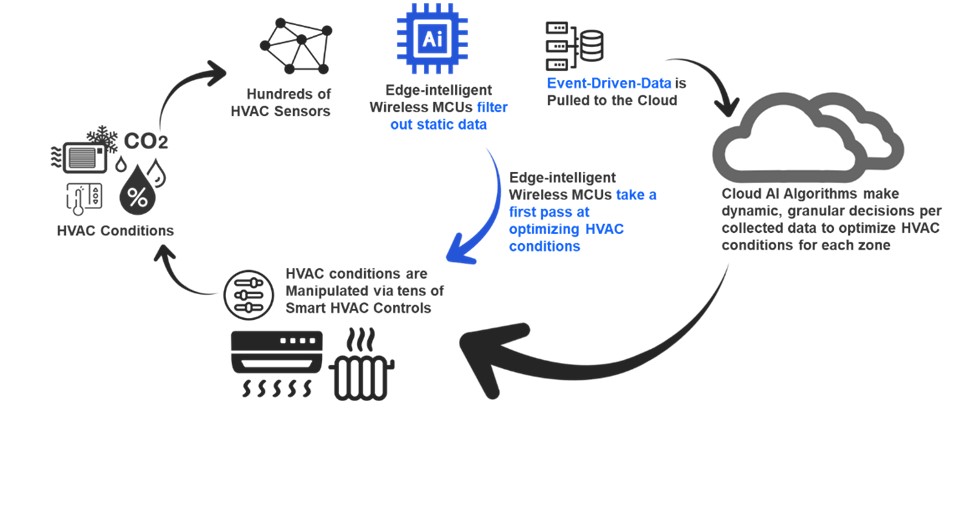In part 1 of this article, we looked at how heating ventilation and cooling (HVAC) systems can be controlled in smart buildings, and the role of zoning systems in improving efficiency and comfort. Now, let’s take a look at how this zoning can be implemented in practice, and the role of artificial intelligence (AI) in making it happen, says Asem Elshimi, smart buildings segment nanager, Silicon Labs.
As we discussed in part 1, zoning systems are an emerging set of smart building technologies, which enable HVAC systems to be controlled in a much more granular way: room by room, or even right down to matching the preferences of an individual occupant. This can include controlling temperature, humidity, ventilation and more.
How can this level of detailed control be achieved? To be cost-effective, it clearly needs to be automated, with the HVAC systems responding to data captured by sensors. This is where AI comes in, making the right decisions based on the information available.
Edge intelligence for smart buildings
Traditionally, AI systems have handled the processing required in some kind of a central computer system. Over the past few years, this has often meant the cloud: data captured from sensors in a building or on the factory floor is sent to a cloud-based system, where AI algorithms make decisions that are then sent back to the HVAC systems for action.
Relying on the cloud does have drawbacks: there’s a delay or latency to send the data and wait for a response, there’s a cost involved in the data transmission, and the system is reliant on a communications link never going down. For a smart building, it can be annoying if the lights don’t come on for a second or two after you push the switch, and you don’t want the heating to fail because there’s an internet connectivity problem.
Instead of cloud AI, another approach is ‘edge intelligence’, where the processing and AI algorithm run ‘at the edge’, nearer the sensors and actuators. This can overcome the limitations of using the cloud. In fact, smart building zoning systems are the perfect application for edge intelligence, due to their proximity to the sensed environments.
However, defining exactly what we mean by the edge can be tricky.
“Where is the edge? If you ask different people, you get very different responses. Telco executives will tell you the edge lives in their data centres at the base of cell towers or in local central offices. Factory operations folks will cite gateways inside their plants. And people like me will look to cellphones or even sensors as the actual edge of the network.” says Stacey on IoT Dec 12th newsletter.
Silicon Labs would agree with Stacey that the network’s edge is in the processing at the sensor level; the edge lies alongside the sensed phenomena. But this is merely one characterisation, and I would argue that there are significant benefits to moving AI computations even further from the cloud.
As I mentioned earlier, there are two major advantages of running AI at the edge: faster decentralised decision making and reduced data traffic. To achieve this for a smart building, we can use edge-intelligent wireless microcontrollers (MCUs) as our processor. These are wireless systems-on-chip (SoCs) that are capable of running AI models with optimised power consumption, and at an acceptable speed.
Why should we run AI applications on a wireless SoC? For industrial and smart building use cases, manufacturers are looking for minimal cost additions when upgrading their products with wireless and intelligent technologies. The processor in an HVAC system is already busy running HVAC equipment applications under heavy safety constraints, so we need another device to handle the AI. Hence, a wireless SoC powered by an AI accelerator offers all the benefits of edge AI, while keeping costs low.
Edge AI: benefits of wireless MCUs
To understand these benefits better, we need to look at the improvement that edge AI can offer versus a regular MCU. Compared to an MCU, an AI accelerator can help applications make decisions more quickly based on a specific data set. It can also do this with higher confidence while using much less power.

The key word here is confidence, which means that an AI application can detect an anomaly or perturbation in an environment, and classify it accurately into a preset category. With an AI accelerator-equipped SoC, AI applications can make more reliable and efficient decisions at the edge without the need to relay any information to the cloud.

In zoning systems, this means that AI-powered applications running on wireless MCUs can make spontaneous decisions based on disturbances in HVAC conditions and changes in occupancy, This significantly reduces the optimisation cycle response time, so occupants don’t have to put up with delays, and energy wastage is minimised.
In addition, it means that the system can run first-order optimisations without sending data to the cloud, enhancing data privacy and security. This localised decision-making also reduces any possible risks from the building backend going offline and taking out the network connection, for whatever reason.
Since AI-powered applications can make reliable judgments on the processed data, they can reduce or even eliminate static data transmission to the cloud. To appreciate this benefit, we need to understand that without edge AI, cloud-based HVAC systems forward all the sensed data, including stand-by data, to the cloud for centralised decision-making. The sensors keep transmitting to the cloud even when nothing happens.
These transmission rates are tolerable with conventional HVAC systems where the number of sensors is low, so cloud AI is an acceptable approach. But with the integration of zoning systems, hundreds of sensors are now online, and eliminating the transmission of static data is necessary. If we did not run algorithms locally, the data flow from allowing millions of sensors to contact the cloud every few milliseconds would swiftly overload the network.
AI accelerators can reduce this data traffic problem. They can provide the processing horsepower needed for applications to filter out all the static data generated by the sensors and reliably make a judgment call on whether a change has occurred, and then only send event-driven data to the cloud. Such filtering optimises network traffic and offloads cloud resources. Building operators particularly benefit from this improvement, because less processing at the cloud means fewer charges by cloud operators, thus significantly reducing operations expenses.
Conclusions
In smart buildings, zoning technologies are set to make a big difference to occupants’ comfort, and to help keep energy costs as low as possible. Within a decade or so, we will witness mass adoption of these technologies, and become as accustomed to the sight of a smart vent as we are to a smart light. To make this all possible, and to handle the data from hundreds of new sensors, running AI algorithms at the edge provides a powerful, cost-effective solution.
The author is Asem Elshimi, smart buildings segment nanager, Silicon Labs.
Comment on this article below or via Twitter: @IoTNow_OR @jcIoTnow










